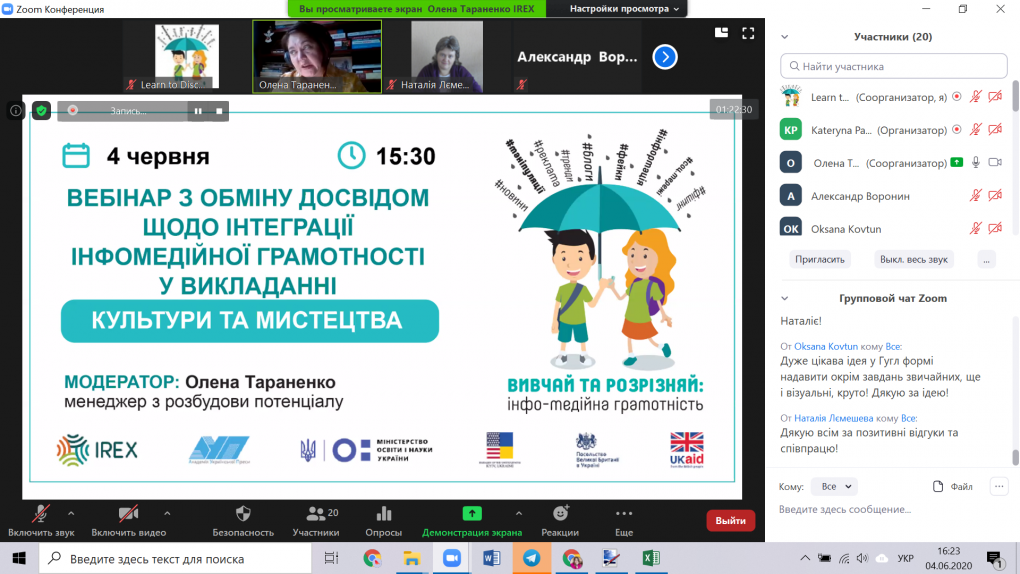
Project “Learn to Discern (L2D) - Media Literacy Training” is proceeding with a series of experience exchange webinars on media and information literacy integration in different types of school classes. This time we have met with art and culture experts. We have spoken about using the interdisciplinary experience as well as the integration of various information and media literacy elements are crucially important for a contemporary approach to education. This is right considering that art is an integral part of our life and a huge part of media environment.
Olena Taranenko, project manager on cooperation with higher educational establishments and regional institutes for continuing teachers’ training, has mentioned that “Art”, as the school subject, is currently in the process of reforming, providing several ways of integration with the other humanities according to the project of Standard for Basic Secondary Education. This provides us new opportunities to incorporate media and information literacy and allows to be even more mobile and flexible than it is provided by the reform. “Our accomplishments are absolutely conforming with the reform of New Ukrainian School and are even getting a little ahead. Integration of media and information literacy is an interlink between different school classes and teachers’ capacity and experience.”
“Precisely our “Art” lessons and exercises, which had been prepared first out of 5 other school subjects, received the stamp of the Ministry of Education and Science of Ukraine and soon will be available,” the expert added.
Integaration of media and information literacy by our participants
Nataliia Lemesheva (Cherkasy Regional Institute for Continuing Teachers’ Training):
“Integrated lessons make education a fascinating process. It is necessary to conduct these lessons for cultivating a holistic sense of self and worldview, and for reflection on phenomena around us. Organizing an integrated lesson requires following the interdisciplinary approach and inspiration by new approaches to ensure the holistic view. In order to elaborate an integrated lesson, one should also look into different syllabuses and introduce the key interdisciplinary lines of education for the school subjects which can merge together. The next stage is to carry out and strengthen the practical focus of school subjects based on implementation of vertical and horizontal linkages. The final milestone is certainly use of general research methods of cognition: experience, surveillance, scientific hypothesis, and experiment. All the mentioned practical activities are on the top of integrated education excellence.”
Some practical life hacks:
Olena Taranenko, project manager at IREX on cooperation with higher educational establishments and regional institutes for continuing teachers’ training:
“What is the most interesting for us? A phenomenon that both journalistic and artistic texts are interpreting the events, contain a certain subjectivity and awareness that any opinion has a right to be expressed in a discussion, if it is argumentated. However, a discussion cannot go on without arguments or realizing that any opinion is just interpretation, hence it is somewhat subjective, but not the absolute truth. Of course, when students work not only by a textbook but with interesting and sometimes sensational facts, they learn to verify information much more efficiently.”
Viktoriia Pishchanska (Dnipro Academy for Lifelong Education):
“We are inviting to teachers to learn a detailed description of the lessons to realize how media and information literacy can be integrated. We have the abbreviations: IM - information material, including text from a textbook followed by images or video recording; AD - analysis of discussion, assessment. We are introducing only the most important information followed by examples on the topic of conducting a 45-minute lesson without contravening the logical rationales of teaching and educational curriculum and incorporating media education and literacy component at the same time.
One’s personal visual media culture is based on general people’s visual culture and is being developed from elementary school. So, if students have a chance to work with one or several creative teachers, one’s personal visual media culture will develop, especially on the examples of learning art. My colleague has studied education in Switzerland and made a conclusion: “The most important school subject in Switzerland is art.” We can assume that the country is successful when its citizens succeed; they are engaged in learning art since childhood, improve their culture of art, visual culture and personal media culture. This is a must have for everybody in digital society.”
Lina Kotova (Bohdan Khmelnytskyi Melitopol State Teachers’ Training University):
“The lesson ‘Preparation of students for a music conversation’ invites teachers to master skills of critical analysis while working with online resources. Students choose a piece of literature for a conversation on a certain topic. Then, they analyze singles, bands, performers, which is typical for identifying fakes while having a music class. When students chose the text, it is important to pay attantion to such notions as a “fact” and an “assumption”. It is also important to mind the details and reliability of source while working with photo content. Media and information literacy is integrated in teaching contemporary music and even playing musical instruments.”
Project “Learn to Discern (L2D) - Media Literacy Training” is being implemented by International Research & Exchanges Board (IREX) with the support of the U.S. Embassy in Ukraine and the British Embassy Kyiv, in partnership with the Ministry of Education and Science of Ukraine and the Academy of Ukrainian Press.